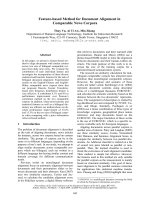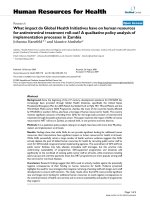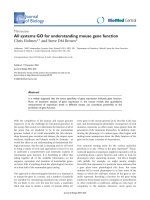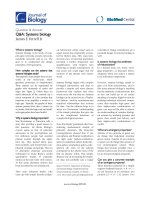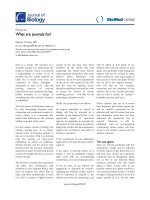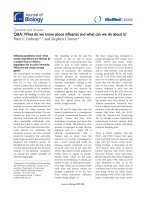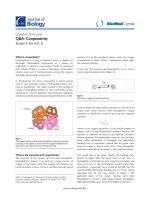Báo cáo sinh học: "What are journals for" doc
Bạn đang xem bản rút gọn của tài liệu. Xem và tải ngay bản đầy đủ của tài liệu tại đây (56.81 KB, 3 trang )
Editorial
WWhhaatt aarree jjoouurrnnaallss ffoorr??
Here is a truism. The function of a
scientific journal is to disseminate the
results of research. It also of course has
a responsibility to ensure as far as
possible that the results reported are
valid. But it would seem from the
comments of many biologists -
sometimes in print [1-3] - that the
policing function of journals
(especially but not exclusively the high-
profile journals) is in danger of
overwhelming their primary function
as publishers.
The chief source of frustration seems to
be with increasingly frequent, time-
consuming and sometimes iterative re-
review which, it is commonly felt,
makes little difference to the eventual
validity or quality of the paper.
For that reason, Journal of Biology will
embark, starting now, on an experi-
mental policy of allowing authors to
opt out of re-review. This is in keeping
with the premise of open-access
publishing, of which our publisher,
BioMed Central, was the pioneer, that
freedom from the practical constraints
imposed by paper and printing should
remove all needless barriers to access to
research results.
The decision to launch the experiment
was taken after consultation with
members of our Editorial Board, who
were on balance (by about four to
one), and often emphatically, in favor
of it. Box 1 contains a highly selective
sample of the raw data. Even those
members of the Board who had
misgivings (on which more below)
often expressed themselves with some
passion about difficulties with
reviewers: one of the most impassioned
of the six we have quoted in fact felt
that the need for rigorous review
should nonetheless transcend the wish
to escape the horrors of current
reviewing practice. - Not that we are
proposing to abandon review.
Briefly, the proposition is as follows.
All papers submitted to Journal of
Biology will first be screened by a
member of our Editorial Board, or an
appropriate expert of equivalent
sagacity, for suitability in principle for
the journal, so that referees are asked to
judge only whether the data adequately
support the conclusions: this policy is
already in operation.
If the conclusions are not adequately
supported by the data the paper will be
rejected.
If the paper is deemed perfect as it
stands, it will be published without
delay (and with an accompanying
commentary, as is our normal practice).
If one or more of our referees has
suggestions or demands for revision,
including the addition of data, authors
will be requested to respond to the
referees and revise the manuscript, and
will be asked at that point to say
whether they wish the referees to look
again. (It is probably worth saying that
authors will not be invited to select
which referees see their paper again: if
they opt for re-review the paper will be
seen by all of the original referees –
who will also see one another’s
comments and the responses of the
authors: this is our normal procedure
and we find it useful, for reasons I
probably need not spell out.)
Where authors opt out of re-review
their responses and revised manuscript
will be carefully scrutinized by the
editorial staff, and if it seems clear to us
that substantive issues have not been
addressed the manuscript may be
rejected. Otherwise it will be
published, with an accompanying
commentary whose author will have
access to the referees’ reports and the
authors’ response.
TThhee ccaassee aaggaaiinnsstt
There are obvious problems with this
proposition. People may be reluctant
to referee papers if they think there is a
risk that their careful and important
comments may be disregarded: about
one in five of our Editorial Board
members indicated that this would
apply to them. Losing 20% of the
possible referees for a paper would be a
very serious problem because it is hard
enough to find good referees to look at
papers quickly as it is. On the other
Journal of Biology
2009,
88::
1
Published: 27 January 2009
Journal of Biology
2009,
88::
1 (doi:10.1186/jbiol111)
The electronic version of this article is the complete one and can be
found online at />© 2009 BioMed Central Ltd
hand, if a substantial number of
authors opted out of re-review, this
would release more time for the
remaining 80%.
Seriously flawed papers might find
their way into the journal. This of
course happens anyway from time to
time with most, if not all journals, and
probably especially with high-profile
journals aspiring to publish particularly
newsworthy results. Referees do not
always see what turn out to be serious
flaws; or, in the case of iterative re-
review where the authors cannot come
to terms with referees, reviewers some-
times just give up. It is not clear that
the end result would be any worse
under re-review opt-out.
These are the two most egregious
potential problems. If I tried to cover
all eventualities and contingencies,
possible modifications to the present
plan, and other strategies for address-
ing refereeing problems (see for exam-
ple Biology Direct, also published by
BioMed Central: logy-
direct.com/info/about/), this editorial
would exceed any reasonable expecta-
tion of its readers’ patience. A fuller
discussion can be found in question-
and-answer form on the Blog site:
/>bmcblog/entry/q_a_the_re_review;
but I will answer here the most
important question: since there are
clearly other possible ways for editors
to resolve the problem of unfairness
and iteration in the review process, why
take this arguably risky step?
WWhhoossee rriisskk??
Just as it is the job of journal editors to
promote the dissemination of research
results rather than to obstruct it, it is
the author who is in the end
accountable for the quality and
validity of the paper that is published.
Editors are responsible for finding, and
referees for giving, thoughtful and
unbiased advice to help the author to
ensure that the conclusions of the
paper are indeed valid and that the text
achieves reasonable standards of
scholarliness and intelligibility. (Earlier
work in the field should be properly
acknowledged and the paper should be
readable without undue pain.)
If there are no flaws in a paper at the
time of submission that should clearly
prohibit publication, it seems to us
reasonable to leave the authors to
decide how much more help they need
to make sure that the published paper
will not damage their reputation (see
Robert Horvitz’s remark in Box 1). It is
often not clear that the revisions
demanded of authors, in particular by
the more selective journals, substan-
tially increase their value. When they
do, it seems that it is sometimes by
insisting on additional data that argu-
ably justify a second paper (see also
[4]), which may have more to do with
enhancing the reputation of the journal
than with helping the authors to
communicate their research.
Moreover there are strong arguments
against a blanket insistence on abso-
lutely rigorous validation of data (some
1.2
Journal of Biology
2009, Volume 8, Article 1 Editorial />Journal of Biology
2009,
88::
1
BBooxx 11
“The refereeing system in the experimental biomedical sciences is badly broken”
Stephen Harrison, Harvard, USA
“…something surely needs to be done about the review nightmare that so many people face”
Arthur Lander, University of California, Irvine, USA
“…what is in the paper is fundamentally the responsibility of the authors, not of the reviewers”
Robert Horvitz, Massachusetts Institute of Technology, USA
“Reviewers have got completely out of hand in the last five years…”
Philippa Marrack, University of Colorado, USA
“I find it mind boggling what trivia the other reviewers keep throwing up which have little to do with the basic
message of the paper but delay manuscripts for months on end”
Brigitta Stockinger, National Institute for Medical Research, UK
“I do feel that in the current system, individual reviewers have inordinate power to make authors jump through
unnecessary hoops”
Bruce Mayer, University of Connecticut, USA
of them are rehearsed for genome-scale
analysis in a comment from Tim
Hughes in this issue of Journal of Biology
[2]). This applies especially in the case
of genuinely novel research, which is
quite likely to raise issues that cannot
immediately be resolved. Tim Hunt will
not mind if I cite him as having
remarked that the paper reporting the
discovery of cyclin, the cell-cycle
regulatory protein for which he later
won (with Paul Nurse and Leland
Hartwell) the Nobel Prize in Physiology
or Medicine, was messy and flawed in a
number of ways. Which is not to say
that journals should be recklessly
publishing all flawed and messy papers
with striking claims in the hope that
they will win Nobel prizes. There is no
escape from hard judgement calls, for
referees and for editors, and we shall
not always get it right. The question is
whether iterative reviewing materially
affects how often we get it wrong.
Journals also have a responsibility to
their readers. If they should be willing to
publish results that are not definitive,
they should also provide a broader
perspective for readers who may not be
equipped to judge the merit of the paper
for themselves. We already publish
commentaries with our research articles,
and it is common practice for general
journals to publish commentaries that
may draw attention to the limitations of
papers making important claims. (Of
course such commentaries may also
serve to explain for non-specialists how
important the paper is.) Under our
experimental re-review opt-out scheme,
the commentaries will become an
important mechanism for ensuring that
readers are alerted to issues that have
not been resolved before publication. It
is not clear how often these will prove
damaging in the end. (One of the
reviewers of the first cyclin paper
apparently said it was ”…wild specu-
lation, based on faulty logic”.)
WWhhaatt eellssee iiss nneeww??
Journal of Biology last published an
editorial about itself on the occasion of
its fifth birthday [5]. What is new since
then? Let me start with what is not
new. Our experiment with peer review
continues a fine tradition of promoting
the interests of authors and to which
indeed some have felt moved to testify
(see [5]). A second good thing that
hasn’t changed is the strong link with
our sister journals Genome Biology, BMC
Biology and the more specialized
journals of the BMC series, any of
which may provide a painless route to
publication of papers that after review
don’t quite meet the criteria for
publication in Journal of Biology.
Meanwhile our major new
development is a greatly expanded
range of commissioned content. You
will find in this issue a brief explanation
from James Ferrell, in question-and-
answer format, of what systems biology
is [6]: this is the first in a series in the
same format on topics of current
interest or fundamental importance on
which readers may feel bemused. As
well as our minireviews exploring topics
arising from papers published in our
sister journals (see for example Whited
and Tabin on limb regeneration in this
issue [7]), we shall be publishing full
reviews: in this issue, by Peter Moore on
the cell’s most important ribozyme, the
ribosome [8]. We have occasionally in
the past published comment: in this
issue Tim Hughes sounds off, in a
restrained way, about the futility of
‘validation’ in genomics papers [2].
Although I am new to Journal of
Biology as Editor, Penelope Webb, in
whose editorial care it has been for
the past two years, remains as
Consulting Editor, and Elizabeth
Moylan as Deputy Editor, to help
uphold the journal’s honorable
tradition of friendliness and courtesy
to authors. New to the journal since
its fifth birthday are Sandra Le
(Senior Editor), who has built the
minireview series, and Elizabeth
Benson (Assistant Editor) who has
just joined us. Penelope and
Elizabeth Moylan in particular
embody the blood ties to our sibling
journals in the BMC series.
MMiirraannddaa RRoobbeerrttssoonn,, EEddiittoorr
eeddiittoorriiaall@@jjbbiiooll ccoomm
RReeffeerreenncceess
1. Raff M, Johnson A, Walter P:
PPaaiinnffuull PPuubb
lliisshhiinngg
Science
2008,
332211::
36.
2. Hughes TR:
‘‘VVaalliiddaattiioonn’’ iinn ggeennoommee ssccaallee
rreesseeaarrcchh
J Biol
2009,
88::
3.
3. Marder E:
TThhee rrooaaddss nnoott ttaakkeenn
Curr Biol
2008,
1188::
R725-R726.
4. Siegel V:
TThhee pprroommiissee ooff ppeeeerr rreevviieeww
Dis
Model Mech
2008,
11::
73-77.
5. Webb, P, Moylan, E:
JJoouurrnnaall ooff BBiioollooggyy
cceelleebbrraatteess iittss ffiifftthh aannnniivveerrssaarryy
J Biol
2007,
66::
5.
6. Ferrell, JE:
QQ&&AA SSyysstteemmss bbiioollooggyy
J Biol
2009,
88::
2.
7. Whited, JL, Tabin, CJ:
LLiimmbb rreeggeenneerraattiioonn
rreevviissiitteedd
J Biol
2009,
88::
5.
8. Moore, PB:
TThhee rriibboossoommee rreettuurrnneedd
J Biol
2009,
88::
8.
/>Journal of Biology
2009, Volume 8, Article 1 Editorial 1.3
Journal of Biology
2009,
88::
1

